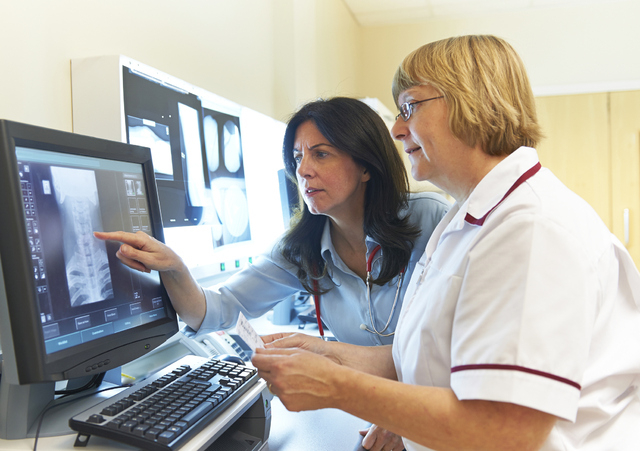Obamacare redefines the private practice
The doctor will see you now — alongside a few of your friends.
Or via Skype, or FaceTime.
Actually, you know what? Don’t bother trying to get in front of your physician. Just send an email, or ask your questions through an online patient portal.
To handle the potential crush of newly insured patients as the Affordable Care Act’s individual mandate takes effect Jan. 1, local doctors are looking for ways to spread the workload. In a state with some of the country’s worst doctor-to-patient ratios, it’ll take some unorthodox approaches to meet the need. Expect a little less one-on-one time in a private exam room, and more visits with groups of patients, or through the Internet. In some cases, you might not see a doctor at all, though there will always be one on hand in case you need one.
It may sound like a brave new world, and possible obstacles range from privacy concerns to the cost of new technologies. But doctors point to benefits for patients, including learning from other people’s experiences and spending fewer hours in the waiting room.
Here are the up-and-coming visit protocols you might see in a doctor’s office near you:
WellHealth Women’s Specialty Care is at the leading edge of a small but growing trend.
The practice lets some patients swap routine one-to-one office visits in midpregnancy for a 90-minute group class called “Centering Your Pregnancy.”
Medicaid gave WellHealth a grant to train for the program, but when the practice launched the class two months ago, privately insured women signed up, too, obstetrician and gynecologist Dr. Keith Brill said. Their co-pays are the same as for a regular office visit, and insurers reimburse the same amount.
Here’s how it works: Eight to 10 expectant moms meet in class every couple of weeks. They’re at the same stage of pregnancy, so they have similar health, nutritional and exercise needs. A nurse-midwife leads the course, giving details and taking questions on everything from the usual aches and pains to signs of premature labor. The women share tips on coping with pregnancy-related problems such as sleep disruptions. To comply with federal health-privacy laws, patients sign confidentiality agreements.
Group pregnancy visits are optional at WellHealth, and they don’t begin until about 14 weeks, after a woman has cleared her first trimester without complications, Brill said. They end as she closes in on her due date, when she needs regular pelvic exams.
Brill said he’s not aware of any other local specialists doing group visits, but he said the model also applies well for diabetes, hypertension or any other common, chronic condition that many patients share.
National figures show most practices have yet to embrace group visits, though they’re becoming more common. Thirteen percent of family doctors reported seeing multiple patients together in 2010, up from 6 percent in 2005, according to a study from the American Academy of Family Physicians.
The practice has its detractors. Dr. Mitchell Forman, a rheumatologist and dean of Touro University Nevada College of Osteopathic Medicine in Henderson, calls it a “very poor way of seeing patients.”
“Though it’s creative, certainly in my experience both as a provider and a patient, I don’t see the value,” Forman said. “It certainly wouldn’t facilitate open discussions of a more personal nature. Many of my patients want to keep their medical histories as confidential as possible.”
But any time a patient has a question about a private matter she gets private time with an obstetrician, Brill said. He added that patients appreciate knowing exactly when their appointment starts, and how long it’ll take.
“This is guaranteed time with the provider,” he said.
You may soon have more options for getting that guaranteed time. Some local practices are looking to add evening hours, Brill said.
“You have teachers, you have culinary workers. It’s hard to get them in for a visit during the day,” he said. “Now that we’re anticipating a higher burden of patient volumes, these kinds of things are on the table. We’re trying to get more flexibility to get people in.”
For some practices, though, the focus is on adding ways to keep people out of the office.
LONG-DISTANCE CARE
At Touro, doctors are experimenting with Internet patient portals.
Instead of coming in for an appointment or leaving a voice mail with a nurse to get test results, change a prescription or ask about a worrisome new symptom, patients can go online and direct-message their doc. It’s especially useful for patients who have after-hours questions, Forman said. The portal is tied in with a practice’s electronic-medical-records system, so doctors can look at a patient’s history as they field a question. They can add the patient’s query to the record to track concerns and issues over time.
“It really is more efficient. It removes the middle-people involved in the process, to some degree,” he said. “When you call a physician’s office, you can be put on hold, or they won’t get back to you right away, or you have a very long list of options to choose from. This removes those impediments. It allows me to address very specific questions without leaving my desk, or after-hours from home.”
It’s also faster for doctors. A call could take 15 to 20 minutes while answering through a patient portal can be done in as little as two minutes, Forman said. He said he may consult with as many as a half-dozen patients a day through the portal.
And though he doesn’t use them now, Forman said Skype, FaceTime and other computer-based, video-calling programs will become more popular among doctors and their patients. That will especially be the case in outlying rural areas, where a routine office visit could be a half-day away.
“It’ll depend on the nature of the problem. If it’s a relatively simple question, that modality (videoconferencing) is useful,” Forman said. “It does give us an opportunity to screen a patient to see if they have a more serious problem. But if someone has chest pain, and their risk for coronary artery disease is higher, I’m not sure these kinds of interactions would be very helpful.”
Beyond telemedicine, more allied-health professionals would also help, Forman said.
Expect to see more advanced practice registered nurses and physician assistants milling around your family practice.
Thanks to recent changes in state law, they’ll be able to take on more responsibilities under doctor supervision. They don’t have the training to replace a doctor, Forman said, but they can be “physician extenders” who handle routine care to free a doc for more complicated cases. Monitoring blood pressure, dealing with an acute asthma attack, supervising a diabetic who doesn’t have a complicated case — all are tasks an allied-health professional could take on, Forman said.
PRACTICAL MATTERS
Of course, change doesn’t come easy. It’ll take some systemwide adjusting before these new models make it to your doctor’s practice.
Why a delay? For one thing, doctors still aren’t clear on how to bill for some emerging services.
Forman said he uses a nonbillable code to enter his patient-portal consultations into electronic medical records. But as patient loads grow and online visits pick up, doctors will have to look for reimbursement from insurers.
Government and private insurers are already adding a huge number of new billing codes, Brill said, and that could complicate things for those who want to try new treatment approaches. The number will more than triple in October, making for a steep, new learning curve just as they’re trying to understand new technologies and how to get paid for using them.
“They’re adding a whole level of complexity none of us has ever seen before,” Brill said.
With the upgraded codes come new privacy and encryption standards. If practices plan to use electronic medical records, online patient portals and emails to answer questions, they must be able to guarantee privacy as well as security from hackers. Most offices will need new software that can cost tens of thousands of dollars per doctor, Brill said, so going 21st century could be a small fortune for some practices.
Because of those hurdles, a lot of local practices aren’t ready for loads of new patients, Forman said.
A SILVER LINING
But one thing could save providers who are behind the curve: Sign-ups through the Silver State Health Insurance Exchange have been slow. The first official numbers, reported Nov. 12, showed 513 people had paid for or scheduled payments for coverage through the exchange. The exchange has targeted 118,000 sign-ups in its first year.
“To some extent, (slow sign-ups) are actually good, because I don’t think we’ll be prepared to handle the number of individuals who’ll now have health insurance in Nevada,” Forman said.
Regardless of barriers in adoption or delays in the patient surge, there’s one practice model that’s on its way out. As romanticized as it is, the small, down-home practice with one or two family docs isn’t likely to work in Obamacare, experts agree.
“It’s the reality of reform. You’re going to need a consolidation of resources,” Brill said. “A one- or two-doctor group won’t be able to offer the structure and services for improving access to care or helping with coordination of care.”
Contact reporter Jennifer Robison at jrobison@reviewjournal.com. Follow @J_Robison1 on Twitter.































